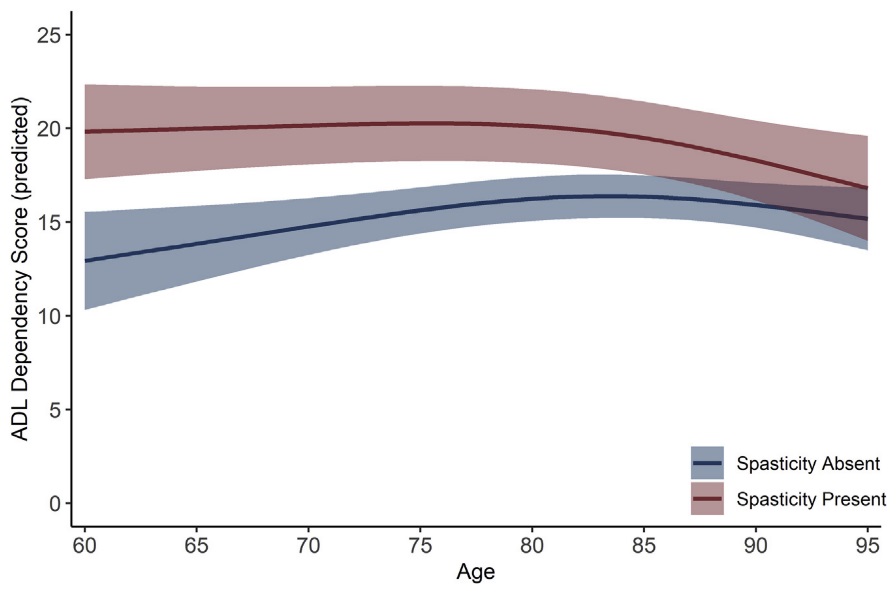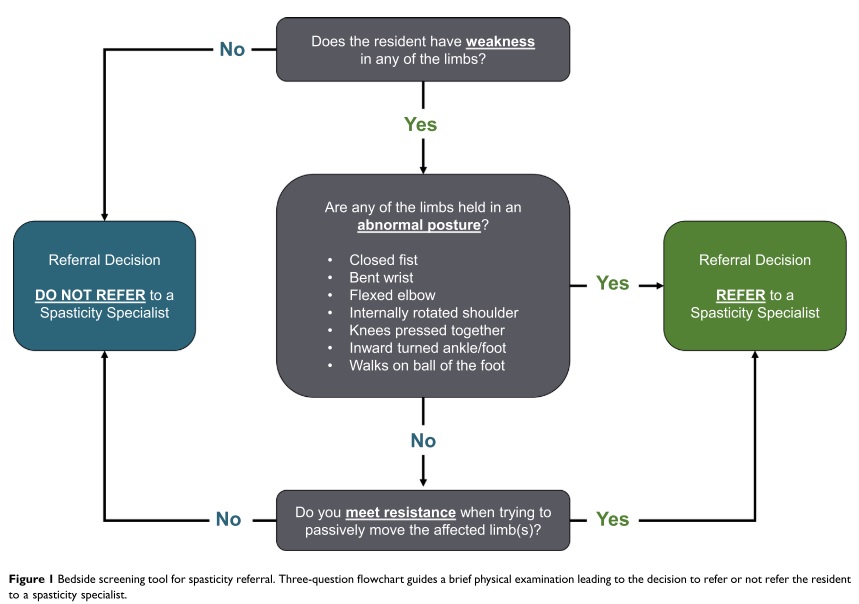Improving spasticity screening, diagnosis and treatment in the long-term care setting
Spasticity is a form of muscle rigidity, which is often experienced by people with nervous system injuries. Spasticity can lead to many negative symptoms, such as increased incidence of urinary tract infection, pain and discomfort, and reduced quality of life. Additionally spasticity may impair activities of daily living, making it difficult to perform care activities for patients who require support. Our current line of research aims to validate the use of newly developed tools to assist with the identification of spasticity and to improve diagnostic criteria through identification of new markers of disease.
Spasticity is Common in the Long-Term Care Setting
| Setting | Spasticity Prevalence | Reference |
| Nursing home | 20% (45/209) | Gill and Hacker et al., JAMDA, 2020 |
| Veterans home | 33% (14/43) | Turchan et al., IJNN, 2016 |
| Veterans home | 35% (17/49) | Hacker et al. Clin. Int. Agiing, 2020 |
Spasticity is Associated with More Dependency in Activities of Daily Living

Partial effects plot of age and predicted activities of daily living score in 209 nursing home residents.
Gill and Hacker et. al., JAMDA, 2020 DOI: https://doi.org/10.1016/j.jamda.2020.01.005
A Simple Bedside Tool Identifies Long-Term Care Residents in Need of Spasticity Referral with High Specificity

Hacker et. al., Clin. Int. Aging, 2020 https://doi.org/10.2147/CIA.S248602
2021
-
Hacker ML, Tomaras MC, Simmons SF, Schnelle JF, Charles D. Enhancing Performance of a Spasticity Screening Tool Using the Minimum Data Set. Journal of the American Medical Directors Association. 2021 Sep 21.
-
Hacker ML, Putman MS, Gill CE, Turchan M, Hudson TS, Currie AD, Phibbs FT, Charles D. Long-Term Care Resident Awareness and Interest in Spasticity Treatments. Geriatrics (Basel, Switzerland). 2021 Mar 3;6(6).
2020
-
Harper KA, Butler EC, Hacker ML, Naik A, Eoff BR, Phibbs FT, Isaacs DA, Gallion SJ, Thomas EP, Scott JL, Ploucher S, Meystedt JC, McLeod ME, Charles PD. A comparative evaluation of telehealth and direct assessment when screening for spasticity in residents of two long-term care facilities. Clinical rehabilitation. 2020 Oct 11. 269215520963845 p.
-
Hacker ML, Tomaras MC, Sayce L, Ploucher S, Naik A, Turchan M, Harper KA, Hedera P, Charles D. Prevalence of Comorbid Spasticity and Urinary Incontinence in Residents of a Long-Term Care Facility. Journal of gerontological nursing. 2020 Oct 1;46(46). 35-42.
-
Tomaras MC, Simmons SF, Schnelle JF, Charles D, Hacker ML. The Minimum Data Set: An Opportunity to Improve Spasticity Screening. Journal of the American Medical Directors Association. 2020 Sep 3.
-
Gill CE, Hacker ML, Meystedt J, Turchan M, Schnelle JF, Simmons SF, Habermann R, Phibbs FT, Charles D. Prevalence of Spasticity in Nursing Home Residents. Journal of the American Medical Directors Association. 2020 Feb 19.
-
Hacker ML, Ploucher S, Naik AG, Turchan M, Meystedt JC, Harper K, Hedera P, Pirtle CJ, Stubblefield K, Charles D. A Simple Bedside Screening Tool for Spasticity Referral. Clinical interventions in aging. 15(15). 655-662.
2016
-
Turchan M, Charles D. Hudson S, Gill E, Currie D, Molinari L, Hacker L, Phibbs T, Tolleson C, Millan H, Heusinkveld E, Grisham J. The Prevalence of Spasticity in Veterans Living in a Long-Term Care Facility Int J Neurol Neurother. 3(3).